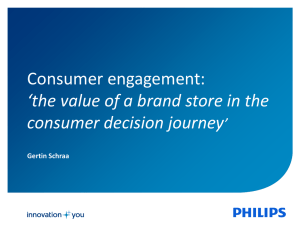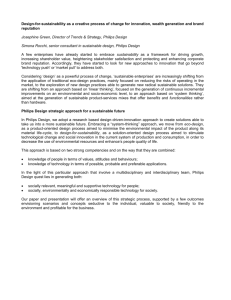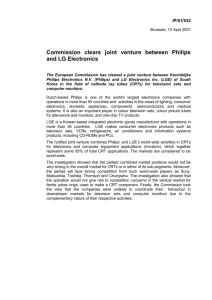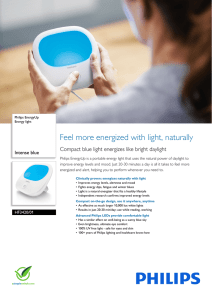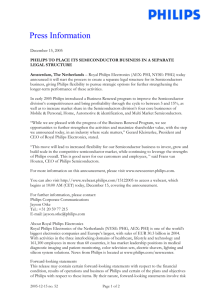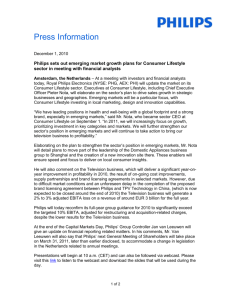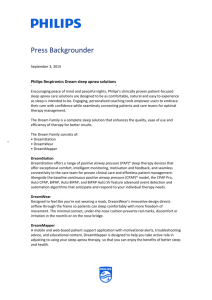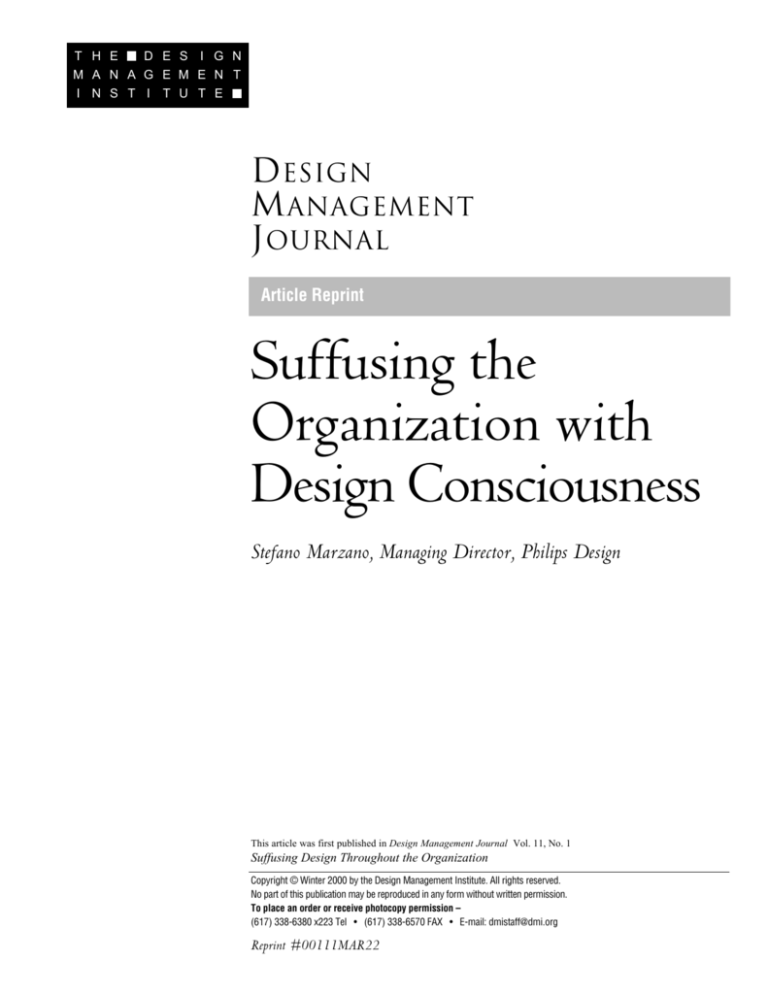
T H E
D E S I G N
M A N A G E M E N T
I N S T I T U T E
D ESIGN
M ANAGEMENT
J OURNAL
Article Reprint
Suffusing the
Organization with
Design Consciousness
Stefano Marzano, Managing Director, Philips Design
This article was first published in Design Management Journal Vol. 11, No. 1
Suffusing Design Throughout the Organization
Copyright © Winter 2000 by the Design Management Institute. All rights reserved.
No part of this publication may be reproduced in any form without written permission.
To place an order or receive photocopy permission –
(617) 338-6380 x223 Tel • (617) 338-6570 FAX • E-mail: dmistaff@dmi.org
Reprint #00111MAR22
D ESIGN
M ANAGEMENT
JOURNAL
VOL. 11, NO. 1
WINTER 2000
EDITOR 'S NOTES
Managing Design as the Way to Do Business
00111WAL06
Thomas Walton, Editor, Design Management Journal
KEYNOTE ARTICLE
Design as Advantage No. 1: The Design + Identity50
00111PET10
Tom Peters, Founder, The Tom Peters Group
THE EXECUTIVE PERSPECTIVE
Redesigning the UK
00111SUM18
Andrew Summers, Chief Executive, British Design Council
Suffusing the Organization with Design Consciousness
00111MAR22
Stefano Marzano, Managing Director, Philips Design
CASE STUDY
From Desktop Publishing to Knowledge Management
00111HOR28
Kate Horne, Former Manager, Corporate Identity and Design Systems, EDS
STRATEGY
Living the Brand
00111ALL35
Dave Allen, Chief Executive Officer, Corporate Branding, Enterprise IG
00111JEV41
How Design Becomes Strategic
Birgit Helene Jevnaker, Associate Professor of Industrial Development, Norwegian School of
Management BI
DEVELOPMENT
Beyond Stewardship to Brand Infusion, Inc.
00111SPE48
Karl D. Speak, Principal/Founder, Beyond Marketing Thought, Inc.
Design Leadership at Herman Miller
00111BEC54
Deanne Beckwith, Global Services Program Manager, Herman Miller Business Services Group
PRODUCTION
Strategic Realization: Building Fundamental Design Values
00111HAR65
Tom Hardy, Design Strategist
Kook Hyun Chung, Executive Design Director, Samsung Electronics Co. Ltd.
Shin T. So, Senior Manager, Corporate Design Planning, Samsung Electronics Co. Ltd.
MARKETING
Beyond the Corporate Sphere
00111SAM70
Roger Sametz, President/Founder, Sametz Blackstone Associates
SUPPORT
Sailing the Seven C’s: Or How to Enlighten an Organization Without
Losing All Your Friends
00111RIE84
Alison Rieple, Director, Graduate Centre–Harrow Business School, University of Westminster,
UK
Full issues and article reprints can be ordered using the form at the back of this booklet.
EXECUTIVE PERSPECTIVE
Suffusing the Organization
with Design
Consciousness
I
T’S CALLED “High Design,” but it’s not
about an elite sense of style. At Philips
Design, Stefano Marzano explains, it refers
to a philosophy that emphasizes the creation
of solutions that fulfill genuine needs and that are of enduring value. It’s an
interdisciplinary approach that takes advantage of technology, but with an
ethical, human touch. It’s a way to open innovative frontiers in design, and it’s a
mode of thinking evident throughout Philips, from units developing consumer
electronics to those making complex medical equipment.
By Stefano Marzano
STEFANO MARZANO,
MANAGING
DIRECTOR,
PHILIPS DESIGN
22
DESIGN MANAGEMENT JOURNAL
Who hasn’t dreamed of being able to change
the world? Who hasn’t tried to imagine how
things could be in a better society? The great
challenge to being an industrial designer in
one of the largest corporations in the world is
that you know you can place a brick in the
building of the future. You know that whatever you design will be produced in millions
of units, purchased by millions of people,
and used in millions of homes—how satisfying, if you create a useful, meaningful product that people really need and want!
But what are the consequences if you
don’t?
When I became head of Philips Design in
1991, I realized the enormous challenge and
responsibility I was accepting. It is my belief
that thoughts alone are not sufficient to create a better future, but that without thought
there is no solid basis for growth. Accordingly, I decided that my first move in this
new position would be to define a design
philosophy and propagate it throughout the
WINTER 2000
organization. I wanted to create a vision and a
mission with which all Philips designers
could identify, and thus enrich themselves
and their work. Since then, this design philosophy, which we call High Design, has
been the principal driving force behind all
our everyday and long-term activities, and it
has been embedded in a design process that is
at the basis of all our work.
High Design is born from the belief that
the spirit of the industrial revolution, based
on the maximization of quantity at all costs,
has resulted—despite all its benefits—in
the loss of many of the old cultural and
essentially human values from our lives. The
result: alienation and emptiness. No one in
particular is to blame. The very nature of our
society made it inevitable. At one time, the
relationship between the user and objects was
one of trust and affection. We would keep
and cherish forever the tool that served us
well, or the shoes that were so comfortable.
But in this throwaway society, which prizes
SUFFUSING THE ORGANIZATION WITH DESIGN CONSCIOUSNESS
newness above proven worth, and flashy
gimmickry above genuine usefulness, we
have forgotten how to care for objects. We
have forgotten that objects are “creatures
produced by our spiritual sensibilities and by
our practical abilities,”1 that they are products of art in its original meaning of techné.
I saw that electronic products had even
more potential to be perceived in this way,
but that they were not. Why not? Perhaps
because they had always taken nonhumanrelated forms (that is, as black, white, or gray
boxes). And why have they always taken
nonhuman forms? Perhaps because they are
perceived as essentially an industrial product,
and most people see industrialization as the
destructive process that spoilt our earth (the
whole environmental problem arose after
global industrialization). Perhaps because
technology, if not managed responsibly, can
cause irreparable damage.
I feel that people should be scared not by
technology itself, but by unethical technology—technology that is an end in itself. In
fact, it is not technology that determines
man’s destiny, but rather man himself, in
deciding in which way to use technology.
The future does not just happen by itself. It
can be influenced by those who are prepared
to shoulder the responsibility for making
decisions today.
Responsible Design
Governments, surely, and—possibly to an
even greater extent—large corporations have
a definite responsibility and a role to play in
shaping the future for us all. Corporations
create, manufacture, and sell large amounts
of goods or services. In the process, they
utilize technological skills and knowledge;
they use natural resources in both the
creation and destruction of the items they
make; and they influence people’s behavior
and lifestyles (just think of how the introduction of mobile phones has changed our
lives). This is why I believe that corporations
should shoulder the responsibility for making the best possible decisions today for the
best possible tomorrow.
We designers also have to bear this
responsibility, in that we play a key role in
the creation of the products and services that
a large number of people will use. We can
create products that people don’t really need,
that are difficult to use, or that don’t fulfill
people’s desires. Consumers might still
purchase these products under the influence
of advertising, fashion, or a sincere personal
belief in the item—but get rid of them
shortly after. In such cases, we designers
would be responsible for contributing to a
further development of the throwaway society. As an alternative, we could create new
products that are the answer not only to
consumers’ needs, but also to their dreams.
We could “father” meaningful objects that
support people in their daily tasks, express
the values they believe in, and stimulate their
emotions and creativity. These products
would not be used and
thrown away in the blink of
an eye, and future generations
would thank us for it.
Against this background,
in 1991, we defined our mission: To create a harmonious
relationship among products,
people, and their environments, both natural and
man-made.
In an attempt to attain this
goal—which is easier said
than done—we have developed a new,
holistic approach to design, in which both
the philosophy and the practicality of design
are worked out with equal rigor by all the
members of our team (450 people worldwide). The philosophical background of
our design is conveyed to all the employees
through lectures, publications, and introductory courses in order to ensure that we all
share the same vision—that we all support
the same ideals.
The world in which we live today is no
longer the black-and-white world that we
once had. People are increasingly complex
and have lost many reference points (political, religious, ideological) that helped them
in the past to make decisions about what was
good or not. To understand what people
want now and will want in the future,
mere statistics are no longer sufficient. If a
company like Philips, a mass producer of
electronic goods, really wishes to create
meaningful products, it needs to get to know
its multi-faceted audience in depth. Only this
knowledge can help us to create products that
truly meet people’s existing and latent needs,
and therefore to be an ethical, as well as
It is not technology
that determines man’s
destiny, but rather man
himself, in deciding in
which way to use
technology
1. This definition is by Ezio Manzini of Domus
Academy, Milan, Italy.
DESIGN MANAGEMENT JOURNAL
WINTER 2000
23
SUFFUSING DESIGN THROUGHOUT THE ORGANIZATION
commercially successful, company. It is
amazing how companies that put the quality
of what they produce, the well-being of their
employees, and a sincere concern for the
consumer and the environment at the top of
their list of values are, in fact, much more
economically successful than those whose
only goal is to generate shareholder value.
High Design
In order to obtain this knowledge of people,
we at Philips Design have created a multidisciplinary, multi-cultural team in which
experts from socio-cultural disciplines
(sociologists, anthropologists, psychologists,
and the like) work together with designers
and with Philips’s technologists, scientists,
engineers, and marketers. The work of these
teams is developed in accordance with
High Design—a research-based process,
seamlessly integrated into our clients’
business creation process, which, due to its
multi-disciplinary approach, guarantees the
human focus of the results.
Philips Design operates as an autonomous design studio within the corporation
and is responsible for the custody of the
Philips brand. Working on a project basis, we
support all the Philips product divisions with
design services that range from strategic
design and identity design to product and
service design and visual communication
design. Although our headquarters are in
Eindhoven, the Netherlands, we have 22
branch studios in several locations in
Europe, Asia Pacific, and the US. We
place members of our team wherever we
need them to support the businesses.
We offer most of our services to the
Philips Group, which is in itself a major
challenge for a design studio, if you consider
how vast the Philips portfolio is (lighting,
domestic appliances, consumer electronics,
industrial electronics, medical systems). This
means that we design all of the Group’s
products, communications, and environments. In other words, its identity.
This may seem more straightforward than
it actually is. Especially in the area of identity
design, it is not easy to convey the same
brand values for a domestic appliance—for
example, a toaster to be used by people at
home—as for a large medical system, such
as an X-ray unit that will be used by hospital
staff. These two products are born from different requirements, aimed at different users,
24
DESIGN MANAGEMENT JOURNAL
WINTER 2000
Figure 1
Integris 5000
Designing medical systems means keeping in mind the needs
of three user groups: the hospital manager (who purchases
the machine), the medical staff (who use it), and the patient
(who will undergo examination in it). In order to satisfy all
these groups, the machine must be easy to install, maintain,
and clean; it must be operable in a natural and instinctive way;
and it must look friendly, reliable, and reassuring.
and purchased by different types of buyers.
Still, if you look at both items carefully, and if
you use them, you realize that both convey
the care and human focus we have put into
their design. This is because the people who
designed them all share the same vision. This
shows how Thoughts can become Facts (see
figures 1 and 2).
Strategic design is a relatively new service
that we offer. Within our strategic design
team, we explore new directions in which
we can create truly human-focused designs
that can feasibly translate into commercially
successful propositions for the Philips
Group and our other clients. These range
from the transport industry to banking and
many other sectors not in direct competition
with Philips. Working for a diversified
portfolio of clients, on a wide range of
design-related issues, helps our design team
to continuously improve its knowledge and
skills, which are our main assets. It also helps
us to identify opportunities to fuse our competencies with those of our clients, in order
to create new areas of business. Working
with “external” clients is a win-win situation.
We offer them our knowledge, experience,
and design approach (developed through
years of work for the Philips Group). And
through the work we carry out for them, we
increase our knowledge and skills, which we
will be able to offer to the next client.
SUFFUSING THE ORGANIZATION WITH DESIGN CONSCIOUSNESS
The main service we offer to external
clients is strategic design. Through our research in the socio-cultural and technology
fields, and by talking to opinion leaders and
experts from different disciplines, we collect
a substantial amount of data on emerging
lifestyles. The analysis of this data gives us an
idea of possible needs and requirements that
people might have in the future; the knowledge of technologies that are currently being
developed helps us to know what we could
feasibly propose to address those needs. The
final data are then translated into various
scenarios for the future, which contain
opportunities for the development of specific
products and services. The purpose of this
whole process is to identify a future that is
not only probable and possible, but also
preferable and in harmony with people’s
values. We call this methodology Strategic
Futures, and we see it as a continuous
learning process that is constantly evolving.
The most recent application of this approach is the project La Casa Prossima Futura
(the Home of the Near Future), which was
presented last September in New York. It is
an exploration of the many ways in which
technology and design can together enhance
the quality of people’s lives in the home
Figure 2
Essence range: Toaster/Sandwich maker
Trends research has shown that people look for peace and
tranquillity in their homes. The design of this product quietly
expresses the essence of the product’s functionalities (it is a
sandwich maker, as well as a toaster) without making a loud
design statement. At the same time, the forms speak
convincingly of its sturdiness, ease of use, and high performance. The color palette recalls ceramics, a material traditionally worked by hand, embodying the full traditional quality
of care and craftsmanship. The Essence range suits the
lifestyle of people who enjoy cooking, are fairly interested in
features, and have an above-average interest in design.
La Casa Prossima Futura
The Home of the Near Future will contain intelligent
objects that can learn to behave in ways that fit our
lives—getting to know our home environment, our
relationships, and our rituals of everyday activities.
The “smart” objects, as well as the physical structure
of the home, will contain and develop an intelligence
that is designed to learn, anticipate, and provide for
our needs. Products will resemble familiar objects
and furniture, with a greater relevance and significance to our home life than the “black boxes”
of today.
The home of the future will look more like the
home of the past than the home of today—no black
boxes, but instead objects that are deeply rooted in
our domestic traditions and that are enhanced by
invisible technology.
La Casa Prossima Futura—The Home of the
Near Future, has recently been shown at Saks Fifth
Avenue, in New York. For further information, visit
www.design.philips.com
DESIGN MANAGEMENT JOURNAL
WINTER 2000
25
SUFFUSING DESIGN THROUGHOUT THE ORGANIZATION
In order to “create a harmonious
relationship among people, objects, and their
natural and man-made environment”—our
mission statement—we need the support of
every individual involved in the creation,
development, sale, and distribution of our
products—the engineers, developers, and
marketers, not to mention the public and
press. This is why we invest so much in
communicating our ideas for the future, not
only toward the end-users, but also within
our own organization.
Designing identity also means creating packaging that
conveys the brand values and communicates the
product’s features.
environment. Beyond the obvious hype
created by the “futuristic” concepts that make
up the exhibition, we hope the public has
understood that we want them to think about
the future with us. As a company, we can help
to shape the future by providing propositions
that may influence the big, small, collective,
and personal decisions that will shape that
future. But we believe people should be at
the center of this “shaping,” and we want
our propositions to match the mental images
people have about how the future will be,
and about the quality of life they want.
“Soft” Communication
The results of our visionary projects are
regularly communicated to the board of
management of Royal Philips Electronics.
The publications that explain the background of the projects are widely distributed
at all levels within Philips and outside the
company. As far as product, identity, and
visual communication design is concerned,
we design every product, interface, and communication in close consultation with the
client, and he or she plays an active role in
the creation process. This allows people who
are not familiar with design to understand
and share our objectives. We also have a
quarterly publication that specifically
addresses the issue of how design creates
value for the organization. In this way, we
A Camera with a Soul
People like using a video camera for e-mail
messages, but some cannot overcome that “Big
Brother is watching you” feeling that cameras
suggest to them. The “anthropomorphic” form of
this product imbues it with emotional values and
therefore creates a friendlier relationship with the
user. The inspiration for the first design proposal
came from the film Toy Story, specifically from the
character of Mr. Potato Head.
Made of environmentally friendly materials,
the Desktop Video Camera is held in the desired
position simply through the friction between the
housing and the rubber feet, thus eliminating the
need for a complicated means of adjustment or a
ball-joint pedestal. The user interface is closely
related to the familiar ones used in consumer
recording devices—simple Record, Forward, and
26
DESIGN MANAGEMENT JOURNAL
WINTER 2000
Rewind buttons are fitted into the intuitive
Windows user interface.
The V-Mail camera received the Gold Industrial Design Excellence Award 1999. The IDSA jury
stated: “Video cameras traditionally have a watchful presence, leaving us ill at ease. Philips has
brought animation and softness to this convention
in a new creature that is playful, yet concise and
essential in its form—confirming its plug-andplay objective. It is successful and
innovative in its pursuit to be
distinctive in the market.”
SUFFUSING THE ORGANIZATION WITH DESIGN CONSCIOUSNESS
gradually increase the knowledge of what
design is and what our design philosophy
means within the organization and outside.
This soft communication has resulted in
strong support for our activities from
Philips’s board of management, which has
become one of the main sponsors of our
visionary projects, and from its product divisions, which regularly commission us to
conduct studies on the future of their business, as well as product, interface, and visual
communication design.
At the same time, through external
communication to the press and the public,
we have contributed to the creation of an
enhanced image for Philips—that of a human-focused company, capable of identifying people’s existing and latent needs and of
addressing them in a positive way.
The biggest challenge arising from our
vision is the fact that it will never be
achieved; fortunately, there will always be
room for improvement and for development. After all, he who stops growing is no
longer alive. I feel that having the courage to
try to contribute in a thoughtful manner,
even with small bricks, day by day, to the
building of our future, is a great challenge
for everyone at Philips Design. ⽧
(Reprint #00111MAR22)
This bookshelf is designed to harmonize with the domestic
environment through its familiar use of traditional materials.
The shelf contains a network connection, a recharging facility
for interactive books, and a printer. The books contain a
touchscreen, a pen and, in some cases, a camera. Each
interactive book represents a “window” through which the
user can access specific subjects, such as home banking,
interactive learning, or the family doctor.
Storyboard enables the user to edit digital media in a simple
way. It consists of a suspended projector, a series of tools,
and a display mat. Media can be accessed from solid-state
storage devices or from a domestic server. Storyboard
provides a simple way for people to edit home videos or
retouch photos using tools that resemble a pen or brush. It
provides new ways to explore personal creativity, from the
compilation of a simple, electronic photo album to a full
multimedia presentation.
DESIGN MANAGEMENT JOURNAL
WINTER 2000
27
Order Form
Order #
Title
Unit Price
00111WAL06 Managing Design as the Way to Do Business
$5.00
00111PET10
$5.00
Design as Advantage No. 1: The Design + Identity50
00111SUM18 Redesigning the UK
$5.00
00111MAR22 Suffusing the Organization with Design Consciousness
$5.00
00111HOR28 From Desktop Publishing to Knowledge Management
$5.00
00111ALL35
Living the Brand
$5.00
00111JEV41
How Design Becomes Strategic
$5.00
00111SPE48
Beyond Stewardship to Brand Infusion
$5.00
00111BEC54 Design Leadership at Herman Miller
$5.00
00111HAR65 Strategic Realization: Building Fundamental Design Values
$5.00
00111SAM70 Beyond the Corporate Sphere
$5.00
00111RIE84
$5.00
Sailing the Seven C’s: Or How to Enlighten an Organization Without
Qty.
Design Management Journal Subscription:
JNL
One Year/Four Issues (US-$96.00/International-$126.00)
$96/126
Subtotal
Minimum Order: $10 plus shipping and handling.
Shipping & Handling:
Domestic: Please add $4 for the first item and $1 for each additional item. Canada: $5 for first
item, $2 per extra item. International: Please add a $4 handling charge. For shipping, you may
either supply us with the account number for your carrier, or we will bill you at cost.
Alternate Shipping via:
My Account number is:
M Check Enclosed (US Dollars, drawn off a US bank)
Charge to:
M VISA
Card #
M MasterCard
M Bill me (DMI members only)
M AmEx
Exp. Date
Signature
Name (please print)
Organization
Street
City
State/Province
Country
E-mail Address
Phone
Fax
Send orders and inquiries to:
Zip/Postal
Design Management Institute
29 Temple Place, 2nd Floor
Boston, MA 02111-1350 USA
Phone: 617-338-6380
Fax: 617-338-6570
E-mail: dmistaff@dmi.org Web site: www.dmi.org
Shipping & Handling
Total
Total
T H E
D E S I G N
M A N A G E M E N T
I N S T I T U T E
published by
The Design Management Institute press
29 Temple Place, 2nd floor
Boston, MA 02111-1350

